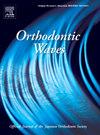正畸锚钉上颌前牵引的生物力学评价:三维有限元分析
IF 0.5
Q4 DENTISTRY, ORAL SURGERY & MEDICINE
引用次数: 0
摘要
摘要目的本研究的目的是对使用正畸锚钉的上颌前伸进行生物力学评估。我们进行了三维有限元分析,通过比较传统的牙齿固定方法和使用正畸锚钉的上颌前伸方法,来确定上颌前伸过程中的初始位移和应力分布。材料和方法我们使用从Hellman Dental Age IIIA干燥人类头骨获得的X射线计算机断层扫描数据来创建骨骼锚定模型和牙齿锚定模型作为有限元模型。在每个模型中,通过牵引钩在咬合平面0°、10°、20°、30°和40°的前后方向上施加6N的载荷,并分析初始位移和应力分布。结果对于鼻前棘(ANS),骨锚定模型的矢状位位移大于牙锚定模型。在中切牙和第一磨牙中,与骨骼锚定模型相比,在牙齿锚定模型中观察到更大的矢状位移。在这两个模型中,垂直位移均为20°,表明上颌骨旋转受到最大抑制。在牙锚定模型中,颧颌和颧侧缝合线在0°和10°处表现出高应力,在骨骼锚定模型的20°、30°和40°处表现为高应力。结论这些结果表明,在腭部插入正畸锚钉的牙齿和骨源性上颌前牵引可能对上颌缺失患者的早期混合牙列期有价值。本文章由计算机程序翻译,如有差异,请以英文原文为准。
Biomechanical evaluation of maxillary protraction with an orthodontic anchor screw: a three-dimensional finite element analysis
ABSTRACT Purpose The purpose of this study was to biomechanically evaluate maxillary protraction using an orthodontic anchor screw. We conducted three-dimensional finite element analysis to determine the initial displacement and stress distribution during maxillary protraction by comparing a conventional method involving fixation on teeth with maxillary protraction using an orthodontic anchor screw. Materials and methods We used X-ray computed tomography data obtained from Hellman Dental Age IIIA dry human skulls to create a skeletal anchorage model and a dental anchorage model as finite element models. In each model, a load of 6 N was applied in the anteroinferior direction at 0°, 10°, 20°, 30°, and 40° to the occlusal plane by means of a traction hook and the initial displacement and stress distribution were analysed. Results For the anterior nasal spine (ANS) sagittal displacement was greater in the skeletal anchorage model than in the dental anchorage model. In the central incisors and first molars, greater sagittal displacement was observed in the dental anchorage model compared with the skeletal anchorage model. In both models, vertical displacement was 20°, indicating maximum suppression of rotation in the maxilla. The zygomaticomaxillary and zygomaticofrontal sutures demonstrated high stress at 0° and 10° in the dental anchorage model, and at 20°, 30°, and 40° in the skeletal anchorage model. Conclusions These results indicate that tooth and bone–borne maxillary protraction using an orthodontic anchor screw inserted in the palatal region may be of value for the early mixed dentition period in patients with maxillary deficiency.
求助全文
通过发布文献求助,成功后即可免费获取论文全文。
去求助
来源期刊

Orthodontic Waves
DENTISTRY, ORAL SURGERY & MEDICINE-
CiteScore
0.40
自引率
0.00%
发文量
0
期刊介绍:
Orthodontic Waves is the official publication of the Japanese Orthodontic Society. The aim of this journal is to foster the advancement of orthodontic research and practice. The journal seeks to publish original articles (i) definitive reports of wide interest to the orthodontic community, (ii) Case Reports and (iii) Short Communications. Research papers stand on the scientific basis of orthodontics. Clinical topics covered include all techniques and approaches to treatment planning. All submissions are subject to peer review.
 求助内容:
求助内容: 应助结果提醒方式:
应助结果提醒方式:


